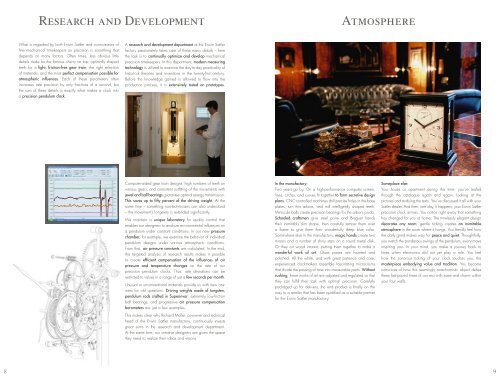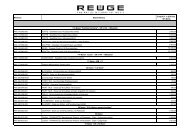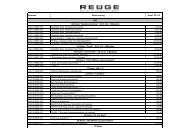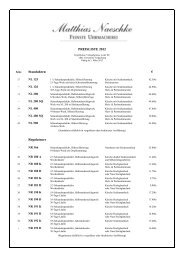TRADITION · PRECISION · PERFECTION - Erwin Sattler
TRADITION · PRECISION · PERFECTION - Erwin Sattler
TRADITION · PRECISION · PERFECTION - Erwin Sattler
You also want an ePaper? Increase the reach of your titles
YUMPU automatically turns print PDFs into web optimized ePapers that Google loves.
Research and Development<br />
What is regarded by both <strong>Erwin</strong> <strong>Sattler</strong> and connoisseurs of<br />
fine mechanical timekeepers as precision is something that<br />
depends on many factors. Often times, less obvious little<br />
details make for the famous cherry on top: optimally shaped<br />
teeth for a light, friction-free gear train; the right selection<br />
of materials, and the most perfect compensation possible for<br />
atmospheric influences. Each of these parameters often<br />
increases rate precision by only fractions of a second, but<br />
the sum of these details is exactly what makes a clock into<br />
a precision pendulum clock.<br />
A research and development department at the <strong>Erwin</strong> <strong>Sattler</strong><br />
factory passionately takes care of these many details – here<br />
the task is to continually optimize and develop mechanical<br />
precision timekeepers. In this department, modern measuring<br />
technology is utilized to examine the day-to-day practicality of<br />
historical theories and inventions in the twenty-first century.<br />
Before the knowledge gained is allowed to flow into the<br />
production process, it is extensively tested on prototypes.<br />
Computer-aided gear train designs, high numbers of teeth on<br />
various gears, and consistent outfitting of the movements with<br />
jewel and ball bearings guarantee optimal energy transmission.<br />
This saves up to fifty percent of the driving weight. At the<br />
same time – something non-technicians can also understand<br />
– the movement’s longevity is extended significantly.<br />
We maintain a unique laboratory for quality control that<br />
enables our designers to analyze environmental influences on<br />
a pendulum under constant conditions. In our new pressure<br />
chamber, for example, we examine the behavior of individual<br />
pendulum designs under various atmospheric conditions.<br />
From that, air pressure constants are calculated. In the end,<br />
this targeted analysis of research results makes it possible<br />
to create efficient compensation of the influences of air<br />
pressure and temperature changes on the rate of our<br />
precision pendulum clocks. Thus, rate deviations can be<br />
restricted to values in a range of just a few seconds per month.<br />
Unusual or unconventional materials provide us with new answers<br />
for old questions. Driving weights made of tungsten,<br />
pendulum rods crafted in Superinvar, extremely low-friction<br />
ball bearings, and progressive air pressure compensation<br />
barometers are just a few examples.<br />
This makes clear why Richard Müller, co-owner and technical<br />
head of the <strong>Erwin</strong> <strong>Sattler</strong> manu factory, continuously invests<br />
great sums in the research and development department.<br />
At the same time, our creative designers are given the space<br />
they need to realize their ideas and visions.<br />
In the manufactory:<br />
Two years go by. On a high-performance computer screen,<br />
lines, circles, and curves fit together to form secretive design<br />
plans. CNC-controlled machines drill precise holes in the base<br />
plates, turn thin arbors, and mill intelligently shaped teeth.<br />
Miniscule balls create precision bearings for the arbor’s pivots.<br />
Schooled craftsmen give steel poire and Breguet hands<br />
their inimitably slim shape, then carefully temper them over<br />
a flame to give them their wonderfully deep blue color.<br />
Somewhere else in the manufactory, magic hands create two<br />
moons and a number of shiny stars on a round metal disk.<br />
Or they cut wood intarsia, putting them together to make a<br />
wonderful work of art. Glass panes are faceted and<br />
polished. All the while, and with great patience and care,<br />
experienced clockmakers assemble fascinating microcosms<br />
that divide the passing of time into measurable parts. Without<br />
rushing, these works of art are adjusted and regulated so that<br />
they can fulfill their task with optimal precision. Carefully<br />
packaged up for delivery, the end product is finally on the<br />
way to a retailer that has been qualified as a suitable partner<br />
for the <strong>Erwin</strong> <strong>Sattler</strong> manufactory.<br />
Atmosphere<br />
Someplace else:<br />
Your house or apartment during this time: you’ve leafed<br />
through the catalogue again and again, looking at the<br />
pictures and studying the texts. You’ve discussed it all with your<br />
<strong>Sattler</strong> dealer. And then, one day, it happens: your <strong>Erwin</strong> <strong>Sattler</strong><br />
precision clock arrives. You notice right away that something<br />
has changed for you at home. The timelessly elegant design<br />
decorates any room; gentle ticking creates an inimitable<br />
atmosphere in the room where it hangs. You literally feel how<br />
the daily grind makes way for peace and quiet. Thoughtfully,<br />
you watch the ponderous swings of the pendulum, every move<br />
inspiring you. In your mind, you make a journey back to<br />
times when electronics did not yet play a role. You feel<br />
how the sonorous ticking of your clock touches you, the<br />
masterpiece embodying value and tradition. You become<br />
conscious of how this seemingly anachronistic object defies<br />
these fast-paced times of our era with ease and charm within<br />
your four walls.<br />
8 9






